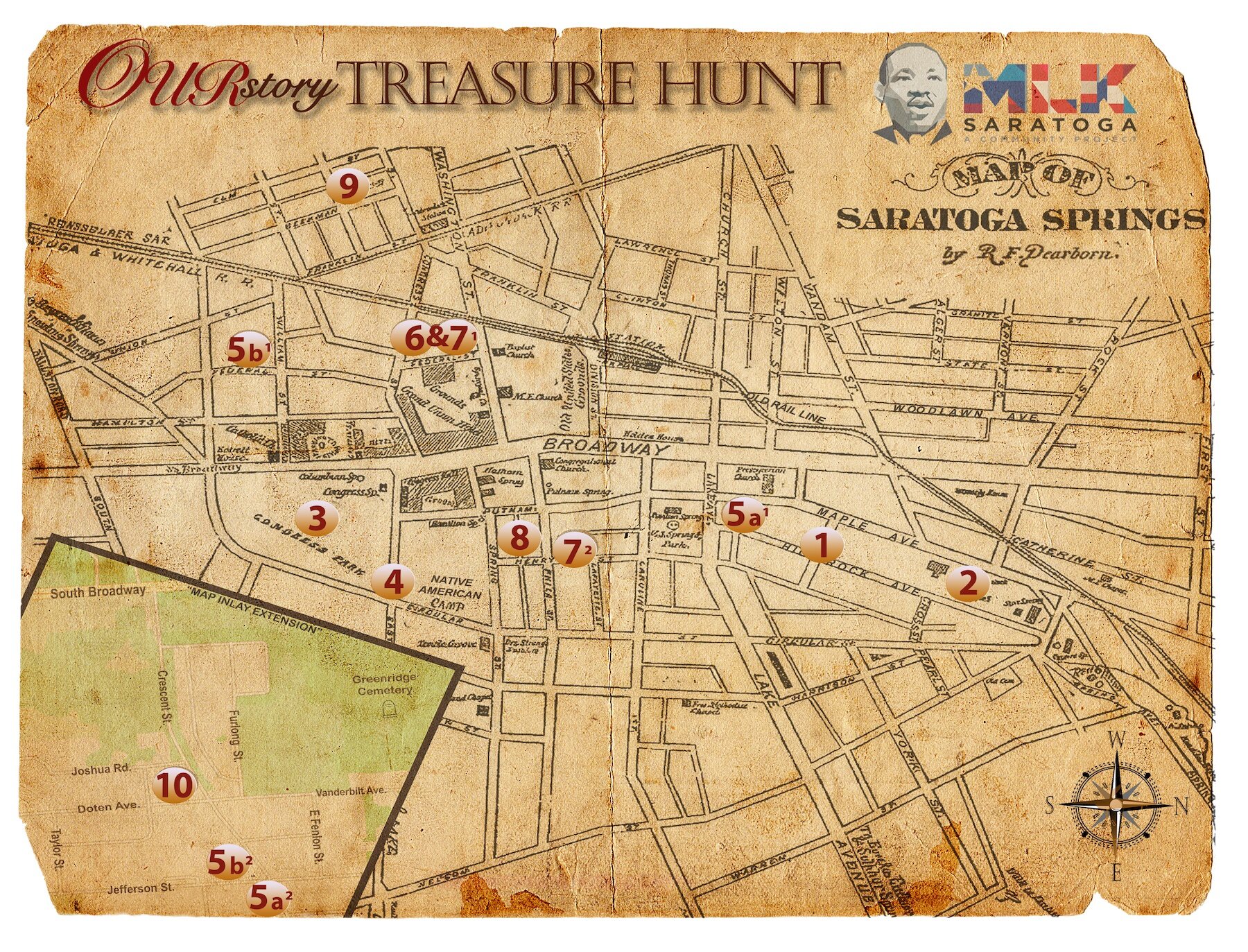OURstory Treasure Hunt Answers
Scroll down for answers … please click on each Treasure Title (in red) to link to a “deep dive” historical information sheet.
These downloadable PDFs include reflection questions and more resources to inspire you to take your Saratoga Springs’ OURstory Treasure Hunt even further!
7. HATTIE’S CHICKEN SHACK & Hattie Moseley Austin: This local favorite’s owner/chef won a throw-down against Bobby Flay! Cooking show fans from Saratoga had our money on this tiny little restaurant that is more than just “finger-licking good” -- and we were right! The OURstory map includes the original location, as well as the restaurant’s current location -- on a street known for diverse cuisines and ice cream with “social justice” roots. Our heroine moved her Shack across town as a result of the city’s Urban Renewal displacement in the late 60’s.
3. THE FIRST PEOPLES OF SARATOGA & Congress Park’s Healing Springs: DON’T feed the ducks that swim in the ponds and splash in the sweet stream that trickles down to the little island with the weeping tree – in the heart of the park in the center of town. DO try the healing spring waters that run from the fountains here! The Mohican & Iroquois -- Saratoga’s First Peoples -- originally named this region Se-rach-ta-gue, meaning “the hillside country of the great river.” These original people would later spend summers here, in an artisan encampment -- up the hill and overlooking the city’s high-rolling gamblers.
5a. & 5b. AFRICAN AMERICAN HOUSES OF WORSHIP: The oldest African American church in Saratoga Springs, New York, Dyer Phelps Memorial A.M.E. Zion Church celebrated its 150th anniversary in 2013. Originally located on what was called Willow Walk(1) -- the more contemporary street names are now Maple and High Rock Avenues -- the site was paved as parking for our City Hall. The church and its community were relocated to the City’s outskirts(2) during Urban Renewal, which began in the late 1960s. Mt. Olivet Baptist Church was also relocated during that time.(2) Can you find where that church originally stood on William and Federal Streets(1)?
10. BRANDTVILLE & Saratoga’s African American Farmers: As original stewards of this land at the southern edge of the city, African American families owned and farmed their property, and were well versed in animal husbandry. This region represents a time and place in Saratoga Springs’ “OURstory” when African American families thrived, prospered, and built wealth for themselves beyond their immediate generation. A century later, these families remain today. The modern street central to this area is between the track to the East and Spa State Park to the West. “DO-take-TEN” minutes to think of this historically forgotten area, located off of Crescent Street.
1. MOUZON HOUSE & The Mouzon Women: This high fashion restaurant, tucked on a hillside by a weeping willow, serves the finest, creative cuisine. Its beautiful brick façade houses a past deeply rooted in a story of Saratoga Springs which is greatly overlooked — how the city was actually built, how parts of it were torn down and people were pushed out, and how two resilient, educated women of color stood up to the wheels of the city’s government. And now …with the abundance of the Farmers’ Market as their neighbor and the new parking garage as their unexpected shade, it houses a wonderful “turn-of-the-century” culinary haven!
4. Tuskegee Airman CLARENCE DART: In the center of town, Congress Park holds Saratoga Springs’ tributes to community members who served our country and to those beloveds we wish to acknowledge and remember. This place invites visitors to contemplate the sacrifices that are documented here. What were we fighting for? What beliefs do we share that make such sacrifices deeply meaningful to us all? And, with regard to this hint specifically, who from our community is missing or forgotten?
9. FREDERICK ALLEN LODGE #609 & MARY A. CARTER TEMPLE #362, I.B.P.O.E. of W. (also known as the Black Elks): With deep roots in Saratoga Springs, this 1845 building is an important hub for our African American community. This “Westside” landmark is located on a street known for noisy, bright summer events at its galleries, artist studios, and small boutiques, as well as fun and fine dining in the darling cottages and turn-of-the-century buildings that line it. Before this street became a popular off-Broadway destination, this area housed many different working-class people, who served the many and varied needs of the growing City.
8. Downtown’s JEWISH NEIGHBORHOOD: It’s not Phila-delphia in the Spring (Street), but we can get great parking in a double-decker lot for any one of the fabulous restaurants – below Broadway and with a great view of the Carousel in Congress Park. Standing on the corner, close your eyes and open your mind to the distant memories of this place. Hear the marketplace babble? Community members chanting prayers? Located along “The Gut” of the City, you can almost smell the fresh bagels in the air!
2. High Rock’s TREE of PEACE: Water bubbles from the earth, jagged sculpture tears the sky. At the bottom of the “High Rock” in the heart of High Rock’s “pocket park,” is a white pine. Pass the Farmers’ Market pavilion, approach the Peace Pole. Here grows the Tree of Peace.
6. THE AFRICAN AMERICAN COMMERCE DISTRICT: In the days long before Saratoga Spring’s Urban Renewal in the late 1960s, a considerable number of homes, businesses and entertainment venues along this Congress Street corridor were owned, occupied and operated by African Americans. Through the 1950’s, these businesses thrived, providing the community with a wide range of services, such as the beauty parlor owned by Mrs. Hattie Saunders and the barber shop owned and operated by Mr. Weaver. During the city’s “Urban Removal” era, commerce and residences were appropriated, sometimes relocated, and very often simply closed down.


